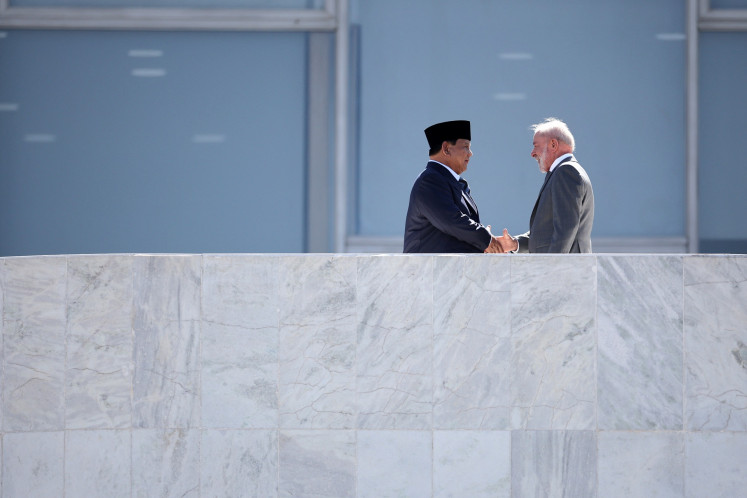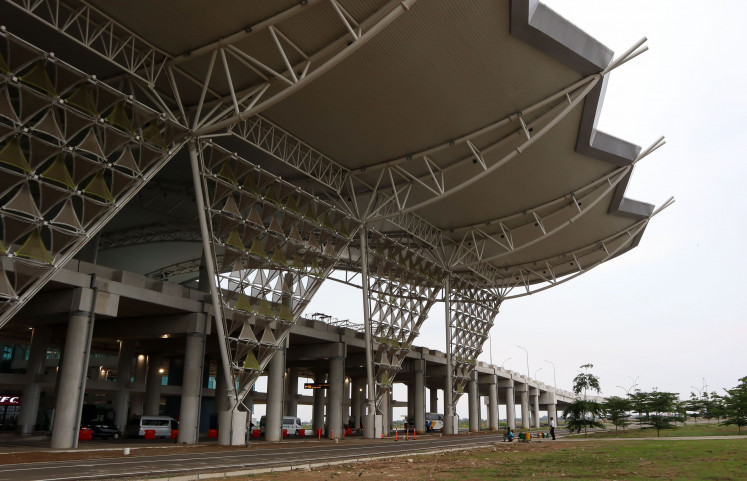Popular Reads
Top Results
Can't find what you're looking for?
View all search resultsPopular Reads
Top Results
Can't find what you're looking for?
View all search resultsThe power of shape
Stand Up for Your Rights by Dolorosa Sinaga
Change text size
Gift Premium Articles
to Anyone
Stand Up for Your Rights by Dolorosa Sinaga. JP/Desy Nurhayati
Slender figures of female Balinese dancers in their lively motions provide a true representation of Dolorosa Sinaga’s search for the essence of shape in her sculptures.
Although her bronze figures do not take realistic forms and have none of the attributes of dancers, Dolorosa has managed to capture the expression of the dancing motion, guiding viewers’ imaginations to see dancing women within the sculptures, thus coming to the conclusion that they are dancers.
In her solo exhibition at Kendra Gallery of Contemporary Art, Dolorosa places the emphasis on building the audience’s perception and understanding through the power of her figurative shapes.
“Dolorosa’s works convey a deep appreciation of the power of shape, which makes us able to sense the movement of bodies dancing energetically,” said curator I Wayan Seriyoga Parta.
“When she is working on her plates, she looks as if she is conducting an operation on a body. Using plates of wax that she rips, shakes and moves, she detaches the plates from bodily structures and turns them into dancing figures.”
In a sculpture titled Balinese Dancer III, for instance, viewers can see a woman dancing with a fan (kipas) using the lithe and lively movements of Balinese dance.
Dance Movement I by Dolorosa Sinaga. JP/Desy Nurhayati
Other pieces that adopt the same theme — dancing — include Dance Movement I and II, Let’s Dance and Dancer I and II. All sculptures are crafted using bronze.
It is not the mere impression captured by a viewer’s naked eye that gives the figures a concrete form; rather, it is something far deeper: One’s memories and experiences of seeing Balinese dancers are being revived.
“Through her artworks, Dolorosa attempts to call these memories back and have us enter the deepest niches of our consciousness. It is much like reopening the pages of a photo album we keep at home,” Seriyoga Parta said.
“It is the process of reimagining that creates the power of Dolorosa’s sculptures, because we don’t just see them with our eyes, but with feelings and memories kept in our minds. She gives us space to resurrect our experiences.”
Dolorosa’s interest in dance movements is closely related to her exploration of “shape” during the 1990s, when she returned from her advanced sculpture studies at St. Martin’s School of Art in London.
There she discovered a truly different art-making process to that she had experienced during her previous years at the Jakarta Art Institute (IKJ).
During her course, she dissected the anatomy of the human body using corrugated paper and cardboard, uncommon materials for creating sculptures. However, this process made her more sensitive to body language and unique expressions for her figures, as she explains, “With the materials, we analyzed every detail of movement. We have to know how the position of muscles changes when they make a certain motion.”
Since the 1970s, she has been engaging with Balinese culture, which she credits with enriching her creative stimulation. The energetic Balinese dance inspired her to make movement and gesture major themes in her work.
The ongoing exhibition also features other works that represent metaphors of rebellion, love, compassion and peace, such as Stand Up for Your Rights (2006), Silent Scream (2008), Dalai Lama (2001), Lover (2007) and Sampai Tua Bersama (2008).
The work Tears for the Loved Ones (2008), showing the body of a woman wrapped in plastic, depicts someone’s sadness for the person she loves.
In other pieces titled You Tell Me (2008) and Sia-sia (2006), which both feature a woman and a man sitting together but separate from each other, Dolorosa attempts to send a message that woman is not a frail creature; she has power and attitude.
Power of the Shape
Sculpture exhibition by Dolorosa Sinaga
Kendra Gallery of Contemporary Art, Bali
Until Nov. 15
Jl. Drupadi No.88B, Basangkasa
Seminyak, Bali
Tel: +62 361 736 628
Fax: +62 361 736 629
enquiries@kendragallery.com
www.kendragallery.com











